
Instagram for schools has arguably been the best-performing social network of the last decade. Now commanding over a billion users, the site’s growth over the past number of years has far outstripped competitors like Snapchat and Twitter, with only its parent company Facebook and Chinese giant WeChat currently commanding a larger audience worldwide.
However, the pace at which it has grown has understandably taken many marketers by surprise, including those in the education sector, and many are only now starting to get to grips with a social network that is still less than a decade old. Even those who were early adopters have faced difficulty as Instagram has introduced new features and the platform has become more crowded.
Whether you’re new to Instagram, or simply trying to keep pace as competition for visibility on the site increases, keep reading for some tips to up your game on this increasingly important channel.
1. Get Smart with Stories on Instagram for Schools
First things first, if your school isn’t using Instagram Stories yet, it’s time to start. Combining photos, video, text, and graphic effects into easily digestible 15-second highlight reels, Stories has undoubtedly been the social media phenomenon of the last couple of years.
Instagram’s version of the feature has over 400 million daily active users, and many top schools have made use of it for everything from behind-the-scenes clips, to Q&As, to student takeovers, and even more casual, fun content like polls and contests.
Example: The Wharton School occasionally uses its Stories feed to share expert business tips.
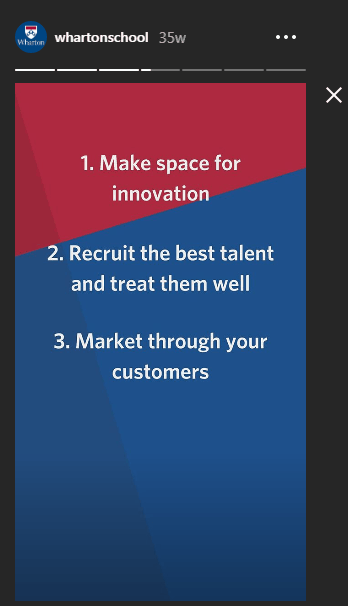
If you’re already posting Stories, there are still a few things you can do to get more out of the feature. For one thing, while Stories disappear from your followers’ feeds after 24 hours, you can save your better posts for future use, and there is also an ‘auto-archive’ feature which can be turned on in your settings. By archiving all your Stories, you can reshare them at regular intervals in order to prolong their shelf-life and extract more value from each post. This can be an especially good option for Stories with evergreen potential.
Example: The University of Chicago created this Story about a student-led trip to Lincoln Park Zoo. Stories which highlight local attractions in your area are a great example of posts which can be reshared again and again.

Another useful feature that you should be making use of is the Stories Highlights section in your school’s profile. This appears at the top of your page, meaning it is one of the first things that visitors see. Simply select your best Stories, and they will be displayed permanently on your profile, allowing them to attract engagement on a continuous basis.
You can choose up to 100 clips, but you would be better off opting for a select few for your Instagram strategy. For best results, think strategically about what to include in your Highlights. Cornell University’s Highlights, for example, are put together almost like a miniature website, which each clip covering specific areas like the school’s history, its research, and study and dining options.
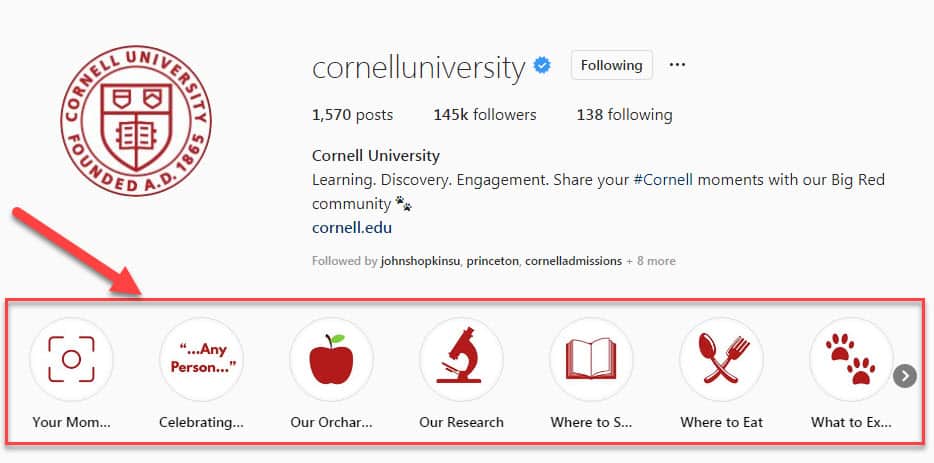
Highlights can also be edited at any time, meaning you can continuously update each one with new visuals to keep them current and fresh.
Example: UCLA’s Campus Life highlight has been continuously updated with new images for almost a year.
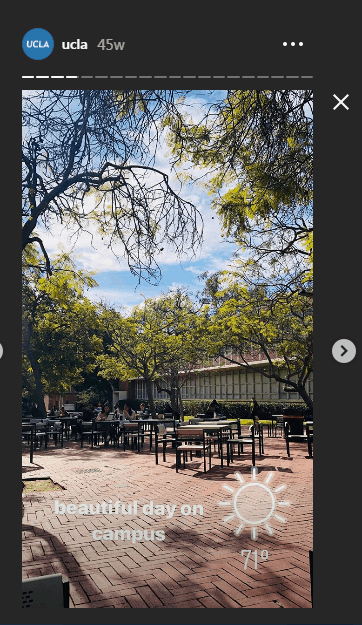
It’s also important to make sure that your Stories are optimized to maximize the engagement they generate. Inserting CTAs within relevant slides that drive traffic back to your website can be an excellent way to do this.
Example: Duke University placed CTAs within this Story about a new project at its medical school.

2. Different Post Formats to Try for Instagram for Schools
While Stories have been the major buzzword on Instagram over the last while, there are also a lot of other posting formats available that can make your social media marketing in your ordinary feed stand out. If your school’s Instagram page is dominated by posts featuring single, simple photos, it might be time to mix things up a little with these Instagram post ideas for schools.
Carousel posts, for instance, can be a great way to feature multiple visuals connected by a common theme. You can include up to ten photos and images in each post in a scrolling slideshow. This can be ideal for things like events, student profiles, or just shots of specific areas around your campus.
Example: Imperial College posted a carousel post featuring photos from an event students attended in Eindhoven.
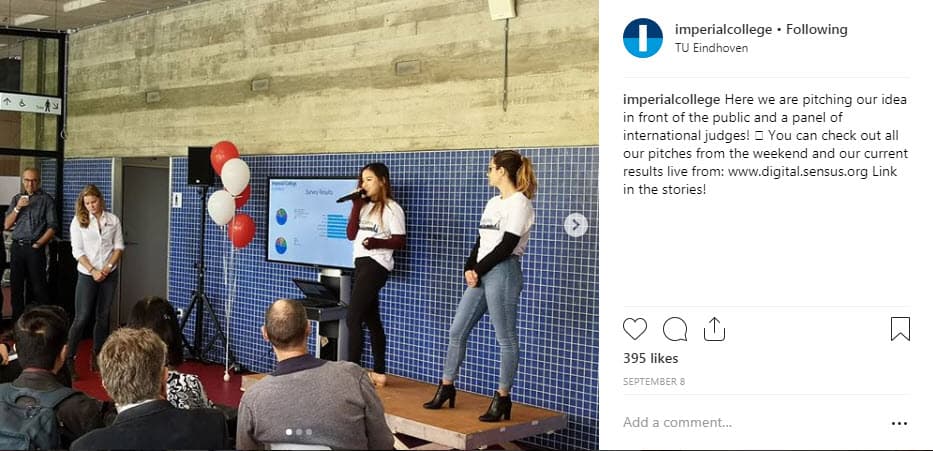

Another great option to spice up your posts is the Boomerang feature, which allows you to create short video clips, which play on a loop, similar to GIFs. This can be a great way to add some colour and fun to your feed.
Example: The University of Michigan frequently makes creative use of Boomerang posts on Instagram.
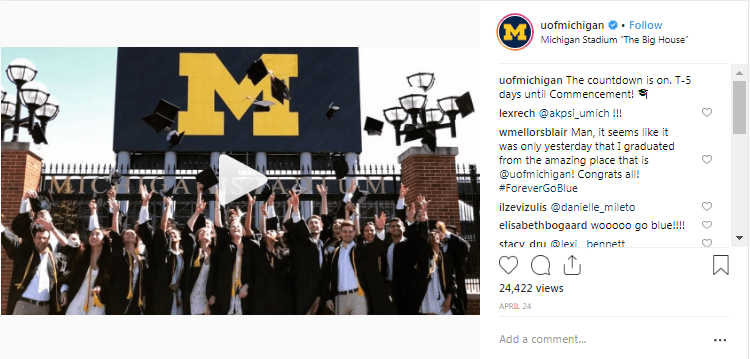
If you have the time and patience, the platform’s Hyperlapse tool is another way to create content on Instagram for schools with a unique feel. Hyperlapse is basically an easy way to create and edit time-lapse videos. You simply start recording, and then use the tool to compress and edit your footage to whatever speed you want once you are done. The result can be an interesting and captivating way to capture life on your campus in full flow.
Example: Boston University created a great Hyperlapse of the view from one of its study lounges.
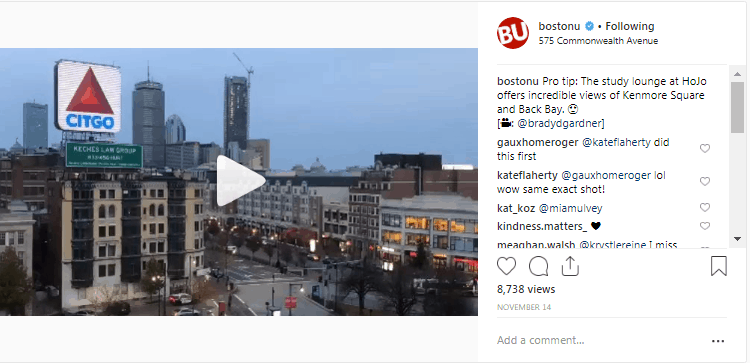
There are countless other features on Instagram that could also produce unusual and striking results for your school, such as filters, stickers, and text overlays. Don’t be afraid to play around with the app and try new things; you might be surprised by what you find.
3. Themed Posting Campaigns can be Very Effective on Instagram
Another way to gain traction on Instagram for schools is to create a series of posts around specific themes or ideas. For instance, many schools have experienced success by creating branded hashtag campaigns. This involves devising a unique hashtag relating to your school and while also encouraging your followers to include it in their posts.
For best results, try to think of something unusual or interesting that will really capture the imagination of your followers, rather than a simple variation on your school’s name or slogan.
Example: Penn State University had great success with its #pennstatelovestory campaign, which encouraged couples who met at the school to share their stories.
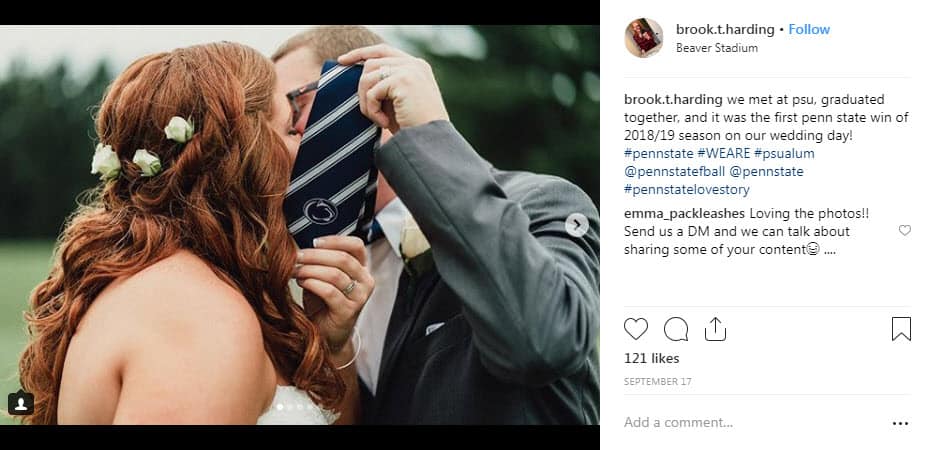
If you’re stuck for ideas, putting your own twist on existing hashtag campaigns or viral trends could be a good place to start. Many schools, for example, have had success creating their own post using the “humans of…” format popularized by Humans of New York.
Example: Binghamton University regularly posts on Instagram using the #HumansofBinghamton hashtag.
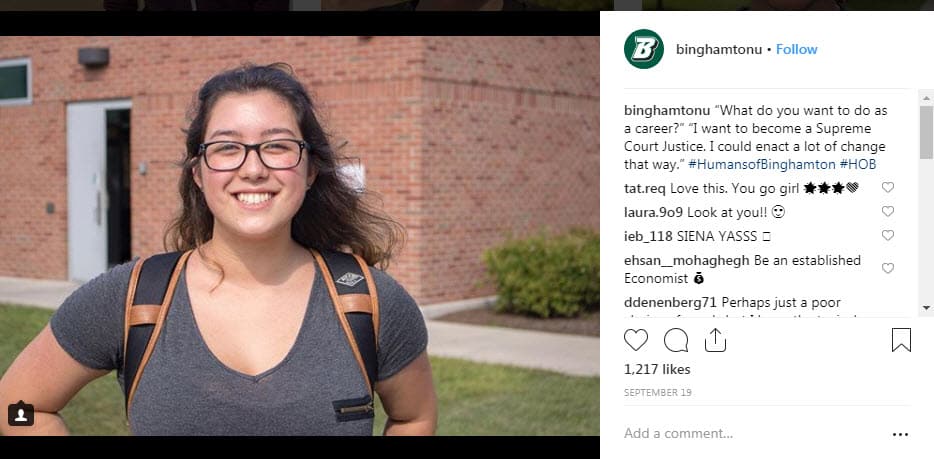
Finding creative ways to feature your school community is always a good idea. Many institutions use Instagram to great effect to post profiles of current students, alumni and staff. These kinds of posts generate a lot of engagement, and add a personal, identifiable touch to your Instagram advertising content.
Example: IH Madrid regularly posts short snapshot profiles of its staff. These kinds of posts can be an excellent way to add some personality to your school.

Another idea is to take a look back at your school’s history for interesting and insightful memories you could share, particularly if the institution has been around for a long time. Dig around your archives, speak to long-serving staff, or even just have a look at old social media posts, and you might be surprised what turns up.
Example: The 400-year-old Trinity College Dublin often features posts on Instagram highlighting its historic past.
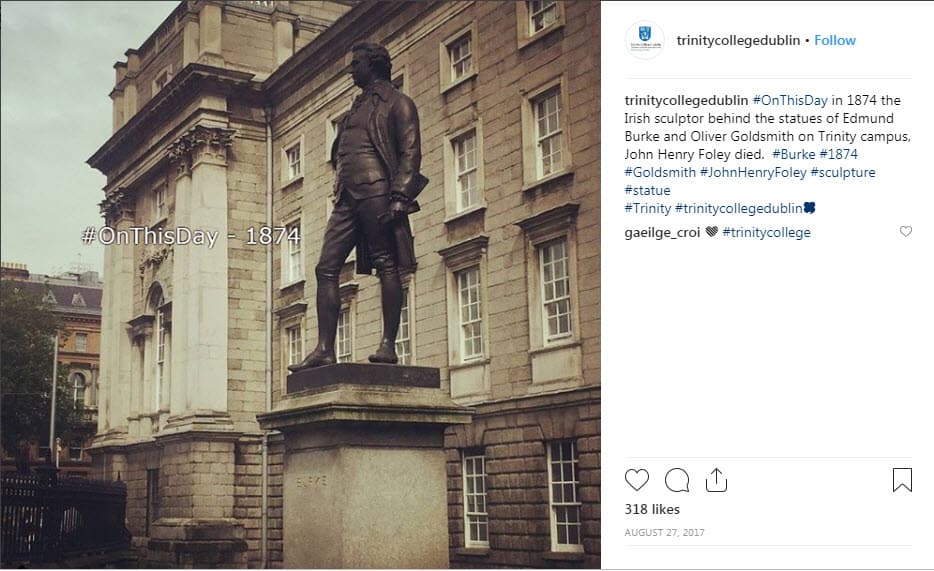
These are just a few ideas for campaigns which could help to take your Instagram strategy to the next level. As is often the case with social media marketing, the key is to have the courage to try new things, get creative, and find strategies which fit the identity and voice of your school.
4. Instagram Direct Could be a Valuable Channel for Student Recruitment
One of the most underused and underrated features in Instagram is Direct Messages. Essentially similar to other instant messaging platforms like Messenger and WhatsApp, Direct doesn’t get nearly as much attention, despite having over 375 million monthly active users and growing at an exponential rate over the last few years:

Schools who do choose to utilize it, however, could find it to be a great tool for student recruitment through instant messaging. Direct can be used to share text messages, photos, videos, posts from your newsfeed, profiles or even locations, and be sent either to individual users or to groups of up to 32 people. There is also the option to send ‘disappearing’ photos or videos which are no longer visible after they are first opened, in a similar manner to messages on Snapchat.
Another crucial thing for schools to consider is that Direct is one of the main ways that Instagram users respond to Stories, since leaving comments on posts is not an option, and direct messages can be sent right from the Stories viewing screen:
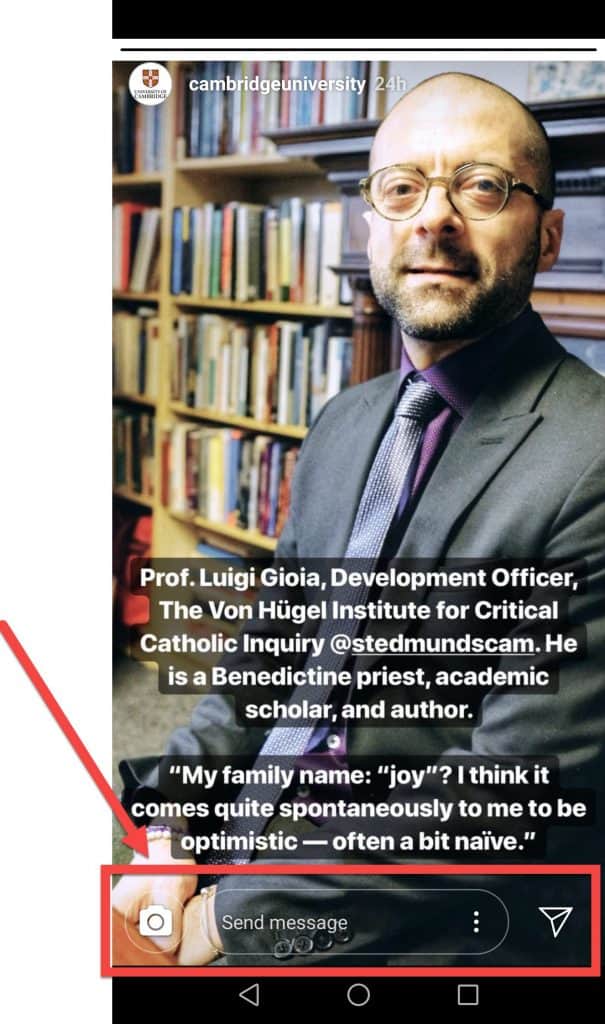
As a result, closely monitoring your Direct inbox can be vital to ensure a quick and timely response to inquiries, especially as the influence and reach of Stories on the platform continues to grow.
5. Could IGTV be the Next Big Thing in Instagram Marketing for Schools?
One of the biggest recent moves Instagram has made has been the launch of IGTV. A separate app for long-form vertical videos up to an hour long, IGTV aims to position itself as a competitor to YouTube, utilizing Instagram’s large loyal user base in order to drive traffic.
Each IGTV user can create their own channel on the app, and many schools have already started posting content there.
Example: The channels of Queens University and the University of Birmingham on the home screen of the IGTV app.
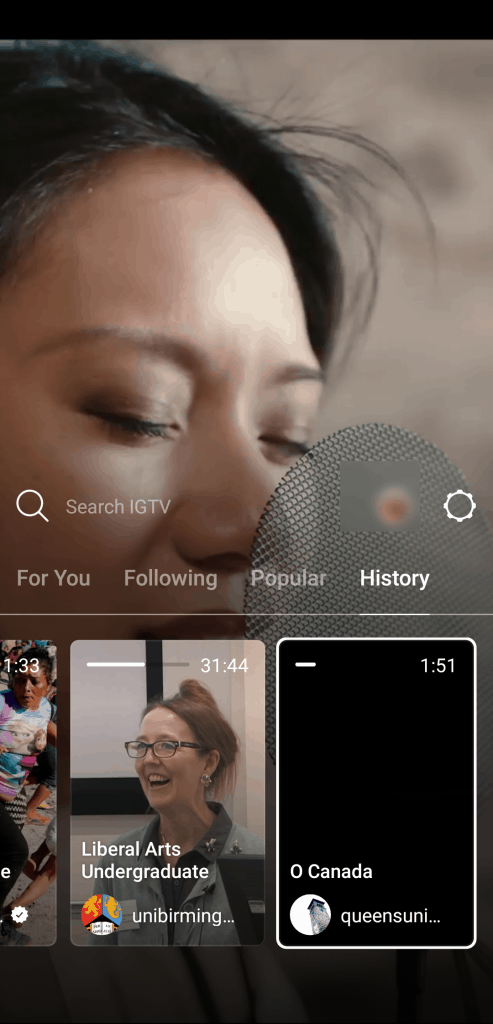
Should it take off, IGTV could be a great outlet for schools to showcase more developed video content than they can on Instagram itself, which currently only supports videos with a maximum length of 60 seconds.
Example: A shot of a video from Humber College that aired on IGTV. You can see that the video has been shot in the vertical format the app uses, rather than as a horizontal clip.

While IGTV could become a big part of Instagram marketing for schools, its worth noting that it hasn’t taken off in the way that the platform’s previous innovations like Stories have. Interest among digital opinion leaders has waned since its launch, and while Instagram has not released any user statistics, it has been noted that individual video views tend to be quite low in comparison to content shared through Instagram’s main site. This suggests that it has yet to capture the imagination of users. Advertising and paid promotions are also not yet available on the app, which could limit its potential reach.
Despite these early teething problems, Instagram is optimistic that IGTV will start to grow with time, and recently added the option for users to preview their videos on the app through their Stories feed, which could increase exposure and drive adoption. Should it begin to gain traction, schools that got in on the ground floor by posting on IGTV could be in an excellent position to reap the rewards.
6. Proper Measurement is Key to Instagram Success for Schools
Whatever approach you take to recruiting students on Instagram, it’s important to track and measure your results properly. While Instagram once had limited analytics compared to other social networks, Instagram Insights now offers comprehensive data about follower demographics, engagement and post reach, and even specific view metrics for Stories.
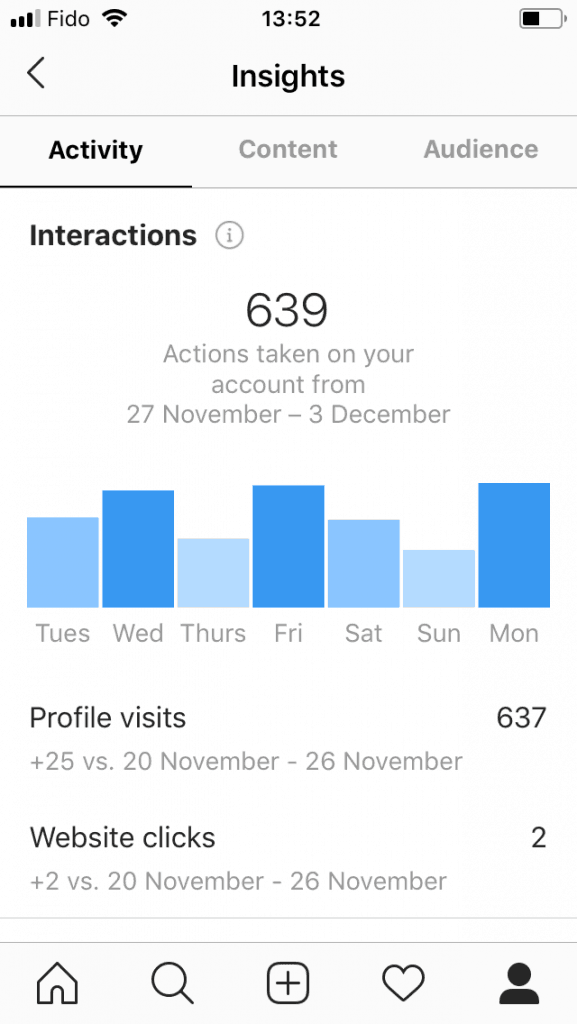
If your school has not been making use of these tools, paying closer attention to these metrics could help you get a better handle on what is working and what isn’t in your Instagram strategies. By building on your successes, you will soon see the rewards for all your hard work.








